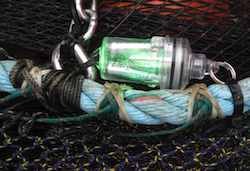Try walking around a strange town on a moonless night with not a star in the sky and not a light on anywhere. To make matters worse, some rather nefarious characters are looking to eliminate some questionable friends of yours that you've been hanging with. The route to safety centers on the one way out of the neighborhood you're in. But it's pitch dark. How to find it? It would sure be nice to have a little light.
Now you know what it's like to be a king salmon in the Bering Sea or a hooligan in the waters off the Pacific Northwest. Both have a troubled relationship with certain associates. For the salmon it's pollock and for the hooligans, also known as candlefish, Pacific smelt and eulachon, it's pink shrimp. And in an ironic twist that nefarious character, the fisherman, also gets pulled into the game.
In all cases, the issue is bycatch. Catch too much salmon or Pacific smelt and the fishery could be shut down.
A single green Lindgren-Pitman Electralume light is zip-tied to the fishing line of a pink shrimp trawl. LED lights attached to trawls are showing promise as a way to reduce bycatch. YouTube screen shotShrimp fishermen are using bycatch reduction devices to keep smelt out of the net. Washington and Oregon shrimpers have rigid-gate BRDs on their trawls with three-quarter-inch bar spacing. Initially that was very effective in eliminating bycatch, but lately smelt bycatch numbers have soared. As a result NOAA is considering protective regulations.
For pollock boats it's more a case of trying to avoid areas with high numbers of chinook salmon.
The answer for both fisheries may be a light, a guiding light so to speak. Last July three fisheries biologists chartered the Miss Yvonne, a double-rigged Oregon shrimp trawler for an unusual experiment.
One of the trawls they towed was a standard net. The other net had a green LED light tied to the footrope. When the nets were hauled back, the traditionally rigged trawl held lots of smelt, along with flatfish, as well as Pacific shrimp.
The catch in the LED-equipped trawl was just about all shrimp. After 42 tows, the illuminated net captured 90 percent less smelt than the traditionally rigged trawl.
Testing hasn't been as extensive with pollock trawls, but early experiments with Wesmar's new BioLight on the headrope of a pollock trawl suggests that it pulls fish away from the mouth of the net. In another case the light was placed in the mesh in front of an escapement hole. The salmon were drawn to the light and out the hole.
It appears that with just a little bit of light, both salmon and smelt can find their way out of a bad neighborhood.







